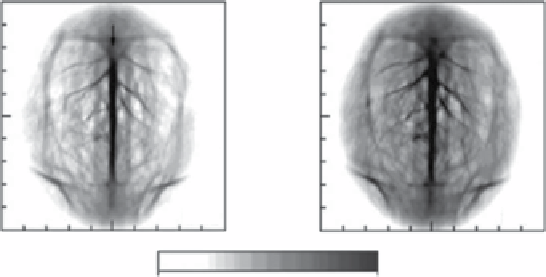Biomedical Engineering Reference
In-Depth Information
MF
(cm)
(cm)
0
1
2
0
1
2
Min
Max
Optical absorption
figure 5.12
Noninvasive
in vivo
OA image of a rat cortical vasculature acquired using
800 nm irradiation before (left) administration of nanoshells (mf: median fissure) and after
(right) approximately 20 min postinjection of the third dose of nanoshells. (Reproduced with
permission from Ref. [117]. © American chemical society.)
in a living animal [33]. for that, Pegylated gold nanoshells (half-life is nearly 4 h in
blood) with a diameter of approximately 135 nm and peak absorption of approxi-
mately 800 nm were injected into the tail vein of sprague-Dawley rats. cortical vas-
culature was noninvasively scanned using PA tomography following nanoshell
injections (three in total). successive OA image acquisition was used to quantify
circulation dynamics, including clearance, in the cortical blood stream (fig. 5.12.
This work illustrated the feasibility of using nanoshells
in vivo
as an NIR contrast
agent in OA imaging, with particular implications in enhancing the sensitivity of cor-
tical blood volume measurements in noninvasive studies of small animal brain
function [33].
5.4.3
gold Nanorods
gold nanorods represent another type of gold nanoparticles whose absorption mech-
anism is based on localized sPR. unlike nanoshells, nanorods exhibit cylindrical
symmetry where small changes in particle symmetry can significantly alter sPR
characteristics [27, 104, 119-121]. The first proposal to use the relation between
ellipsoidal and cylindrical plasmonic nanorods and OA imaging of different modal-
ities was described by Oraevsky
et al
. in the beginning of the 2000s [119, 120, 122,
123]. shortly after, nanorods were proposed for OA technique for flow measure-
ments with the use of laser-induced shape transitions [124]. A series of studies were
performed to investigate the shape dependence of the optical absorption of gold
nanorods, as well as the shape transition induced by pulsed laser irradiation [125]. It
was found that photon-induced shape transition of nanorods involves mainly a rod-
to-sphere conversion and a shift in the peak optical absorption wavelength. The
application of laser pulses induces shape changes in gold nanorods as they flow
through a region of interest, and the quantitative flow information can be derived
based on the PA signals (measured as a function of time) from the irradiated nanorods.

Search WWH ::

Custom Search